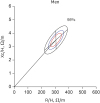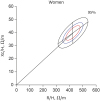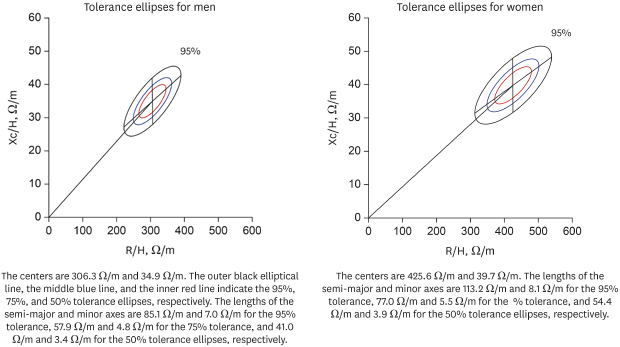1. Parrinello G, Paterna S, Di Pasquale P, Torres D, Fatta A, Mezzero M, et al. The usefulness of bioelectrical impedance analysis in differentiating dyspnea due to decompensated heart failure. J Card Fail. 2008; 14(8):676–686.

2. Norman K, Stobäus N, Pirlich M, Bosy-Westphal A. Bioelectrical phase angle and impedance vector analysis--clinical relevance and applicability of impedance parameters. Clin Nutr. 2012; 31(6):854–861.
3. Foster KR, Lukaski HC. Whole-body impedance--what does it measure? Am J Clin Nutr. 1996; 64(3):Suppl. 388S–396S.

4. Buchholz AC, Bartok C, Schoeller DA. The validity of bioelectrical impedance models in clinical populations. Nutr Clin Pract. 2004; 19(5):433–446.

5. Kyle UG, Bosaeus I, De Lorenzo AD, Deurenberg P, Elia M, Manuel Gómez J, et al. Bioelectrical impedance analysis-part II: utilization in clinical practice. Clin Nutr. 2004; 23(6):1430–1453.

6. Chamney PW, Wabel P, Moissl UM, Müller MJ, Bosy-Westphal A, Korth O, et al. A whole-body model to distinguish excess fluid from the hydration of major body tissues. Am J Clin Nutr. 2007; 85(1):80–89.

7. Steele IC, Young IS, Stevenson HP, Maguire S, Livingstone MB, Rollo M, et al. Body composition and energy expenditure of patients with chronic cardiac failure. Eur J Clin Invest. 1998; 28(1):33–40.

8. Yang EM, Park E, Ahn YH, Choi HJ, Kang HG, Cheong HI, et al. Measurement of fluid status using bioimpedance methods in Korean pediatric patients on hemodialysis. J Korean Med Sci. 2017; 32(11):1828–1834.

9. Piccoli A, Rossi B, Pillon L, Bucciante G. A new method for monitoring body fluid variation by bioimpedance analysis: the RXc graph. Kidney Int. 1994; 46(2):534–539.

10. Johnson RA, Wichern DW. Applied Multivariate Statistical Analysis. Pearson New International Edition. 6th edition. Harlow: Pearson Education;2014.
11. Piccoli A, Nigrelli S, Caberlotto A, Bottazzo S, Rossi B, Pillon L, et al. Bivariate normal values of the bioelectrical impedance vector in adult and elderly populations. Am J Clin Nutr. 1995; 61(2):269–270.

12. Atilano-Carsi X, Bajo MA, Del Peso G, Sánchez R, Selgas R. Normal values of bioimpedance vector in Spanish population. Nutr Hosp. 2014; 31(3):1336–1344.
13. Piccoli A, Pillon L, Dumler F. Impedance vector distribution by sex, race, body mass index, and age in the United States: standard reference intervals as bivariate Z scores. Nutrition. 2002; 18(2):153–167.

14. Mulasi U, Kuchnia AJ, Cole AJ, Earthman CP. Bioimpedance at the bedside: current applications, limitations, and opportunities. Nutr Clin Pract. 2015; 30(2):180–193.
15. Norman K, Smoliner C, Valentini L, Lochs H, Pirlich M. Is bioelectrical impedance vector analysis of value in the elderly with malnutrition and impaired functionality? Nutrition. 2007; 23(7-8):564–569.

16. Castillo Martínez L, Colín Ramírez E, Orea Tejeda A, Asensio Lafuente E, Bernal Rosales LP, Rebollar González V, et al. Bioelectrical impedance and strength measurements in patients with heart failure: comparison with functional class. Nutrition. 2007; 23(5):412–418.

17. Castillo-Martínez L, Colín-Ramírez E, Orea-Tejeda A, González Islas DG, Rodríguez García WD, Santillán Díaz C, et al. Cachexia assessed by bioimpedance vector analysis as a prognostic indicator in chronic stable heart failure patients. Nutrition. 2012; 28(9):886–891.

18. Norman K, Smoliner C, Kilbert A, Valentini L, Lochs H, Pirlich M. Disease-related malnutrition but not underweight by BMI is reflected by disturbed electric tissue properties in the bioelectrical impedance vector analysis. Br J Nutr. 2008; 100(3):590–595.

19. Piccoli A, Brunani A, Savia G, Pillon L, Favaro E, Berselli ME, et al. Discriminating between body fat and fluid changes in the obese adult using bioimpedance vector analysis. Int J Obes Relat Metab Disord. 1998; 22(2):97–104.

20. Piccoli A. The Italian Hemodialysis-Bioelectrical Impedance Analysis (HD-BIA) Study Group. Identification of operational clues to dry weight prescription in hemodialysis using bioimpedance vector analysis. Kidney Int. 1998; 53(4):1036–1043.

21. Pillon L, Piccoli A, Lowrie EG, Lazarus JM, Chertow GM. Vector length as a proxy for the adequacy of ultrafiltration in hemodialysis. Kidney Int. 2004; 66(3):1266–1271.

22. Alves FD, Souza GC, Aliti GB, Rabelo-Silva ER, Clausell N, Biolo A. Dynamic changes in bioelectrical impedance vector analysis and phase angle in acute decompensated heart failure. Nutrition. 2015; 31(1):84–89.

23. Lukaski HC, Vega Diaz N, Talluri A, Nescolarde L. Classification of hydration in clinical conditions: indirect and direct approaches using bioimpedance. Nutrients. 2019; 11(4):E809.

24. Atilano-Carsi X, Bajo MA, Del Peso G, Sánchez R, Selgas R. Normal values of bioimpedance vector in Spanish population. Nutr Hosp. 2014; 31(3):1336–1344.
25. Moissl UM, Wabel P, Chamney PW, Bosaeus I, Levin NW, Bosy-Westphal A, et al. Body fluid volume determination via body composition spectroscopy in health and disease. Physiol Meas. 2006; 27(9):921–933.

26. Silva AM, Matias CN, Nunes CL, Santos DA, Marini E, Lukaski HC, et al. Lack of agreement of in vivo raw bioimpedance measurements obtained from two single and multi-frequency bioelectrical impedance devices. Eur J Clin Nutr. 2019; 73(7):1077–1083.

27. Ellegård L, Aldenbratt A, Svensson MK, Lindberg C. Body composition in patients with primary neuromuscular disease assessed by dual energy X-ray absorptiometry (DXA) and three different bioimpedance devices. Clin Nutr ESPEN. 2019; 29:142–148.









 PDF
PDF Citation
Citation Print
Print





 XML Download
XML Download